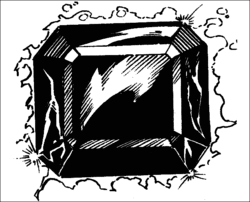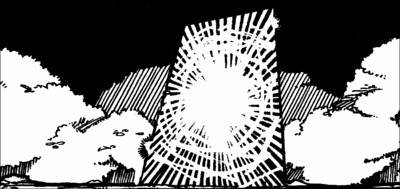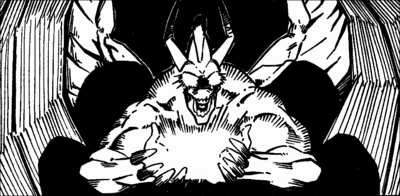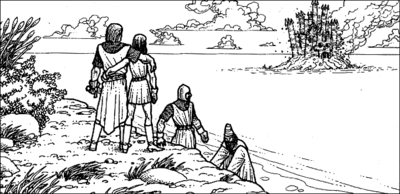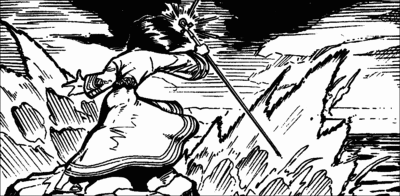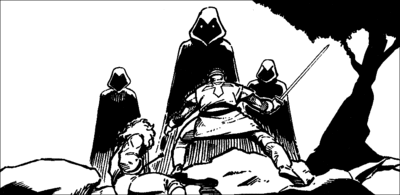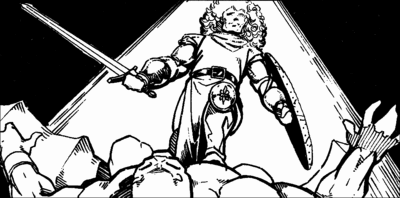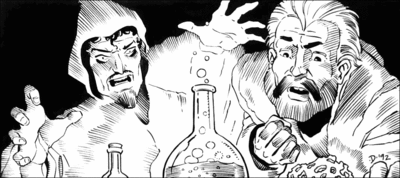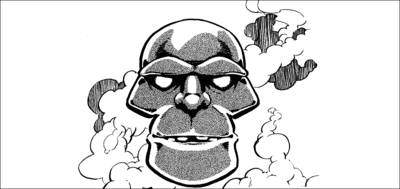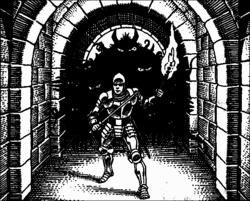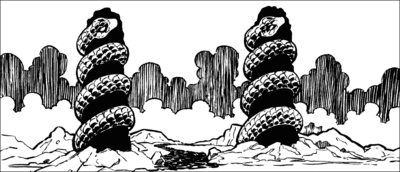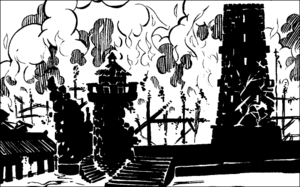History of Britannia
This article is about the in-game history of the main world of the Ultima series. For the book that came with Ultima IV, see The History of Britannia.
The history of the land now known as Britannia is a very long one, full of turns and surprising events. This will be a rough overview over the history so far (through Ultima VII Part Two and including the events of Ultima IX for informational purposes).
For a timeline of these events, see Timeline of the Ultima universe.
Ancient Sosaria[edit]
The first to settle Sosaria was a race of beings known only as the Ancient Ones, who managed to defeat the daemons that were trying to claim this world as their own. Binding them to their will, some of these beings vanished to a higher state of being, while others became mortal. They settled the land, in harmony with nature and magic. However, on one fateful day, over half a million years ago, the Xorinite wisp traded with the mage Zog, giving him the Armageddon spell. Zog was foolish enough to try the spell. All life died on Sosaria, wiping out every sign of the Ancient Ones. Zog, alone in his empty world with his guilt, died shortly after.
It would take a long time before life returned to Sosaria, but eventually the land was re-settled by different races, mainly humans. Eight kingdoms surfaced on the four main continents, and civilization started to develop once again. The people of Sosaria became mistrustful of magic when witnessing how holding such power could corrupt magic users into power-hungry monsters. Thus, in the end magic was banned and all magic-users hunted down. Of course, magic could not be completely wiped out, and some users went underground, but the ban held for many generations.
One day, the youth later known as Lord British entered the lands of Sosaria. Under the guidance of Shamino, he grew up to be the youngest ruler in Sosaria's history. And it was good that he came, because Sosaria was about to face the darkest times ever seen in history.
The Ages of Darkness[edit]
- Main article: Age of Darkness
Akalabeth[edit]
- Main article: Akalabeth
Mondain, a young, very troubled, yet very powerful magician and prince, murdered his father, Wolfgang, in jealousy over his elder brother's birthright and out of desire for his father's ruby gem, a powerful artifact capable of harnessing the power of the Sosarian sun. Creating horrible beasts and recruiting bloodthirsty monsters to do his bidding, Mondain came to war with the kingdom of Akalabeth, although his forces were routed by the youthful Terran knight, British of the White Light.[1]
In exchange for this deed, British was granted kingship over half of the nation, and put out the word for heroes to come, that the last of Mondain's monstrous creations might be ousted from the land. Mondain in the meantime, lusting after limitless power, turned the magic of the Sun Ruby Gem against itself, creating the black Gem of Immortality, such that his life and works might become endless.[2]
The First Age of Darkness[edit]
- Main article: Ultima I
The horrors Mondain unleashed were serious enough that the ban on magic was lifted – though everyone knew such a ban could never be enacted again. But the long years of the ban had literally wiped out all knowledge about magic, thus giving Mondain a serious advantage. A thousand years separated the creation of the gem, and the coming of the hero who would eventually put an end to it.[3] During this time, monsters and beasts plagued the tumultuous lands of Sosaria, with the eight kingdoms of the fractious lands falling into civil strife and petty feuds. The wizard, in the meantime, made strange alliances with creatures that lived among the stars, turning the very heavens hostile. Throughout the harried Sosarian landscape, high technology intermingled freely with the medieval devices of the time, with crafts for skimming the heavens and weapons that could shoot beams of light taking their place along the standard devices of war and sorcery.
Now an established ruler, Lord British held his serpentine amulet and wished that a champion might come to at last free the lands of their travail. Miraculously, a Stranger, native to the king's very own Earth arrived in Sosaria,[2] and after a long quest, managed to secure a device capable of traveling through time to the point before Mondain's gem was complete. It was here, in the wizard's fortress, that this hero shattered the mystic gem before it could be made indestructible and slew its would-be creator once that deed was done.
The total impact this event had on the remainder of Sosaria's, and later Britannia's, history cannot be said for certain, and it is not known how much of the world's course had been changed with Mondain's demise. The land of Sosaria, however, transformed dramatically, with three of its major continents vanishing as though they had never existed, leaving only the Lands of Lord British amid the sea's waves.[4] Only many years later would the mystery be solved what happened to those lands, when one was re-discovered.
For the next thousand years, the Stranger slept, to be reawakened by the grateful young British when the ages turned to such a point as they were when the hero had first left in the machine. The savior of Sosaria was greeted by an assembly of thousands and promised by British the service of all of his realm for time immemorial.[5]
The Revenge of the Enchantress[edit]
- Main article: Ultima II: The Revenge of the Enchantress
Unbeknownst to many, Mondain had taken on an apprentice and paramour: Minax the Enchantress. Enraged by her mentor and lover's death, this sorceress vowed revenge, though also just being a twelve-year-old girl at the time of his death, it would take a decade before she reached the maturity needed to master her vast powers. Using her mastery over time to warp the course of humanity on the Stranger's homelands of Earth, she drastically altered Terran history. Minax created a world which ended in nuclear fire in the year 2111 A.D., with the foremost nations of the planet obliterating one another in a catastrophic holocaust.
Despite such a grim future, some were able in some way to survive this calamity, through means of magical time doors which opened onto various points in the world's time line, allowing travelers to escape to ages less perilous. Some of these survivors, under the leadership of Lord British, managed to collaborate such as to trace the disaster of the twenty-second century to Minax's interventions from her stronghold, Shadowguard, within the enigmatic Time of Legends.[6]
The Stranger, presumably back on Earth and once more summoned by British's intervention,[2] escaped the changes in the timeline and partook of a desperate mission to destroy Minax. Crossing both time and space to gain the blessing of the mystic Father Antos, and with it the ring necessary to lay siege to Shadowguard, the hero entered the sorceress' keep and slew her with the quicksword, Enilno. Upon her death, the changes which her machinations had wrought faded from existence, and time resumed its normal course.
During these events, the hordes of the enchantress terrorized Sosaria as well and were only defeated when her very death shattered any kind of co-ordination between them, dissolving to small war bands that were defeated by the realm's army one after the other. With the danger being over it was felt that the worst was behind the world, while in reality, the worst was still to come in the following years in the form of the legacy left behind by Mondain and Minax.
Exodus[edit]
- Main article: Ultima III: Exodus
What no one could have foreseen was that Mondain and Minax had worked together to create an even greater evil than both of them together. Part daemon and part machine, it was more powerful than both by its very nature. Its name was Exodus and the sudden loss of both of its creators made it decide to make the world pay.[Citation needed] For twenty years, Exodus gathered information about its enemies, calculating the best way to strike and defeat them all. When no one suspected a third Age of Darkness, Exodus launched its attack.
First, the Isle of Fire rose from the ocean, where Exodus located its castle. Ripping the Great Earth Serpent out of the Ethereal Void, it used the mystical snake to guard its fortress, a vile act which would have bitter consequences for a different world. Then the evil being started to feast on Sosaria. Pirate fleets and sea monsters, rallied by it, swept clean the seas, while hordes of disgusting monsters roamed the land and slaughtered everyone they found. Exodus itself started to poison the very soul of the land with the knowledge it had gained over the years, slowly starting to twist it to its bidding. The attacks were highly confusing as well, since apart from the barest facts, no one knew what Exodus was.
The Stranger returned for a third time. This time, three companions fought at the hero's side to defeat Exodus. Meeting the Time Lord, the Stranger learned that Exodus could not be defeated by normal means due to his very dual nature of demon and machine. Going to the lost island of Ambrosia, the Stranger recovered the Four Cards. Then sailing to the Castle of Fire, the heroes fought their way through Exodus' guards, with even the very floor turning against them, before reaching the core of the machine that bound the various parts of Exodus together. Inserting the Cards in the correct order, the machine exploded and shattered the connection between Exodus' soul and the physical parts, thus bringing the end of the being known as Exodus and the last Age of Darkness.
The Age of Enlightenment[edit]
The Establishment of Britannia[edit]
Following Exodus' defeat, the land of was re-formed again in a cataclysmic upheaval when the forces bound in it were set free all at once, re-shaping the land to its current shape. The sheer destruction caused by such a cataclysm and the death toll caused by Exodus' minions ensured that long years of poverty and need followed,[Citation needed] as the land recovered from the horrors that had been forced upon it. After the defeat of the remnant forces of Exodus, the local city-states were united to a single kingdom in the end, under the rule of Lord British, thus, the kingdom of Britannia was born. This also started the modern calendar.
However, while the kingdom became politically and economically stable again and finally prospered after all the horrors of the dark years, something was missing within the people. Lord British finally saw what was wrong. While the material wealth was secured, the people of his kingdom lacked a spiritual path at which they could direct themselves after having looked into the dark abyss so many times in the past. Thus, he established the system of the Eight Virtues, building the eight shrines, for that they would bring enlightenment to the people and help them through life.
This did not go without conflict, however, as several groups did not want to accept the new ways the land was going. The mages of Moon believed in magical superiority and that magic in its very nature was based on illusion, thus they saw the mages of Britannia now following the way of Honesty as inconceivable. The warriors of the Montors felt that no other virtue should stand beside Courage, and felt marginalized by the fighters of Jhelom and the Order of the Silver Serpent.[Citation needed] The beauty-worshippers of Old Fawn were offended that their narcissistic belief in beauty was rejected as a virtue by the government, who saw it as a direct path to Pride – the opposite of Humility. All three groups in the end left Britannia under the nominal leadership of the mage Erstam, sailing through the Serpent Pillars for a land unknown at that point in history.
Another setback came when the city of Magincia fell away from the path of Humility and instead gave itself to Pride. The excessive Pride in the end attracted a horde of daemons which slaughtered most of the inhabitants and left Magincia as a ruin.
Quest of the Avatar[edit]
- Main article: Ultima IV: Quest of the Avatar
However, over the years Lord British realized that while the people gladly accepted the Virtues as new guide for their lives after the horrors of the past, they also needed someone who would serve them as a role model. Someone living the Virtues and helping them to understand how the Virtues could help in their everyday lives. An embodiment of the Virtues was needed, a man or woman who would show the people the boons of a virtuous life and set good example – a standard for which to strive. So he called out the Quest of the Avatar: a quest to master all eight Virtues and reach the source of highest wisdom in Britannia, the Codex of Ultimate Wisdom, and gain part of its wisdom.
Many tried themselves on the quest, and while some had partial success in one or a few virtues, they never reached the goal of becoming a role model in all virtues and reading the Codex. Most failed on the quest. But the call also reached the Stranger on Earth. Following the call, the Stranger went on the Quest of the Avatar as well. Becoming a master in all eight of the Virtues, the Stranger showed the people how to use the Virtues practically to master life and find inner peace. The Stranger gathered friends, who would become the best companions imaginable, before going on the last part of the quest. Entering the Abyss on what would later be known as the Isle of the Avatar, the hero reached the Codex of Ultimate Wisdom in its lowest depths. The ancient book gave the final blessing to the Stranger after passing the final test on the Virtues and the deeper meaning behind the whole system, something Lord British intentionally never told anyone: the Axiom of Infinity.
And on that day the Stranger became the Avatar, the hero of Britannia and embodiment of all the eight Virtues. The people of Britannia had found their role model for a virtuous life and rejoiced at the news. They themselves had found their spiritual path.
The Closing of Doom[edit]
After the Quest of the Avatar, Lord British reformed Britannia to slowly abolish the absolute monarchy and give the land a government more fitting with the Age of Enlightenment. A democratic element, the Great Council, was established to gradually democratise the monarchy and leave behind the totalitarianism of the past. Each city would send one elected representative into the council, though Lord British did reserve the power of veto for himself. One of the first acts of the Council was to draw the Codex of Ultimate Wisdom out of the Abyss, so that it could bring Britannia its wisdom, and enshrined it on the re-named Isle of the Avatar inside the Shrine of the Codex.
This act however created magic resistance from the Abyss, which did not want to release its most valuable treasure from its depths, resulting in it throwing out enough mass to form a new massive mountain around it, which in turn resulted in the ground of the dungeons collapsing, freeing the path to the Underworld, a vast underground network of caves. Horrible creatures ascended from it through the dungeons and terrorized the land. In order to repair this self-inflicted disaster, the Great Council sealed the seven remaining dungeons, so that the evil in them should never again escape and taint Britannia.
During that time, the city of New Magincia was built upon the ruins of Magincia, after the ghosts of the past were finally put to rest.
Warriors of Destiny[edit]
- Main article: Ultima V: Warriors of Destiny
However, no one could have known, that these acts would lead to the freeing of the three Shadowlords. Foul beings born from three shards of the Gem of Immortality, they personified the three anti-thesis of the Principles: Falsehood, Hatred and Cowardice. When a group lost in the Underworld found the three shards, the evil in them caused Captain Johne to go insane and kill his friends with them. From their blood, the three beings rose and after hiding the shards went on to spread their evil. They kidnapped Lord British during an expedition in the Underworld and locked him into the depths of the dungeon Doom, before twisting the mind of Lord Blackthorn, who ruled Britannia in Lord British's absence.
Blackthorn, once a kind, humble and virtuous man, became cruel and installed a tyranny, twisting the virtues into diabolical laws, where morality was enforced with the sword. Virtue had however come from oneself, and state-ordered morality would lead to horrific misuse. Blackthorn outlawed the companions of the Avatar, while installing an inquisition and the Oppression to suppress any opposition against his regime. At the same time, the Shadowlords terrorized the cities of Britannia, forcing the people to follow their will like puppets. It was in this time of need when the Avatar returned to Britannia.
Confronted with a tyrannical Britannian regime, the Avatar fought against the forces of evil with the Companions. Joining with the Resistance, Blackthorn's regime was weakened on several fronts, while the Avatar unsealed the dungeons to reach the Underworld and its secrets. In end the Avatar found a way to destroy the three Shadowlords after learning how to banish them from reality once and for all: by throwing their shards into the Flames of the Principles. The hero then travelled into the deepest pocket of the Underworld to unseal dungeon Doom, where Lord British was found imprisoned by magical means. Freeing him with the Orb of the Moons caused the end of the tyranny. Blackthorn, now freed now from the forces twisting his mind, was devastated over his actions and chose to leave Britannia forever through a moongate to give the people peace and redeem himself, after outside forces had tainted him so much.
The sheer number of atrocities committed by the people following the Oppression would be a lasting burden for Britannia in the years to come.
The False Prophet[edit]
- Main article: Ultima VI: The False Prophet
The rescue of Lord British resulted in horrible earthquakes, which, ignited by the clashing magics of the Orb of the Moons and dungeon Doom, caused the total collapse of the Underworld. This caused a catastrophic effect on the connected Realm of the Gargoyles and thus to the Gargoyles themselves. And also, they feared the fulfillment of a old prophecy, the prophecy of the False Prophet – the Avatar. Two of the three events had taken place, the Codex had been taken from them by the Great Council, and their world was in shambles and slowly being ripped apart by the void. In great fear that the last part – the destruction of the Gargoyles at the hands of the False Prophet – would take place, they attacked Britannia in sheer desperation.
The war was horrible, with many deaths, atrocities, and bitterness on both sides – but time was against the Gargoyles, their world vanished more with each day. Feeling the pressure to avoid the prophecy at all cost, the Gargoyles disabled the realm's moongates by removing the moonstones and enclosing them in force fields on the now occupied eight shrines. They then lured the Avatar into a trap by sending an Orb of the Moons to the hero's world and tried to sacrifice the Avatar ritually to stop the prophecy. Freed by the loyal companions at last second, the Avatar fought back against the Gargoyles invading the land, freeing the Shrines and liberating the moonstones, before forcing them out of Britannia.
But then, after finally being able to translate the Book of Prophecies recovered from the near-sacrifice, the truth came out into the open. Feeling obliged to end the war and rescue the Gargoyles from destruction, the Avatar surrendered to their leader so they could learn how to stop the seemingly inevitable. Eventually, it was revealed that the Codex was the biggest point of bitterness between humans and Gargoyles. The Avatar then understood that "sacrificing" the Codex of Ultimate Wisdom back into the void where it came from would also fulfill the letter of the prophecy and remove the central source of conflict. The Codex from then on only being visible to read with two special lenses, both kings learned the truth about each other from it, and the war finally ended with peace. The prophecy had resolved itself in an unexpected way.
The Stygian Abyss[edit]
- Main article: Ultima Underworld: The Stygian Abyss
A difficult time began, in which the Gargoyles had to be integrated into Britannia, and the bitterness of the war was very deep. During that time, Sir Cabirus planned a colony on the Isle of the Avatar, and in the Abyss, in order to promote Virtue and perform an experiment in the peaceful coexistence of several races. The colony was approved by Lord British and at first seemed successful, but with Cabirus' untimely death the peace began to unravel. The old problems between the factions broke up again without a draconian leadership suppressing them. In the end, the entrances were sealed, and the Abyss became a prison.
The wizard Tyball murdered his brother Garamon after the accidental summoning of a powerful daemon known as the Slasher of Veils and kidnapped the daughter of Baron Almric, Arial. Intending to murder her ritually, so that he could access the daemon after spilling her blood, the Avatar returned, called by the dead Garamon. However, the Avatar instead was accused of the kidnapping by the grieving Baron and thrown into the Abyss to either rescue Arial or perish in the dark hole.
There in the depths the hero learned the truth about Tyball and the Slasher of Veils. Killing Tyball and rescuing Arial, however, did not remove the danger, as the freed Slasher threatened untold damage to Britannia. Therefore, the Avatar banished the Slasher into the Void using the power of talismans representing the Eight Virtues, before fleeing the Abyss, which had started sinking into boiling lava. Britannia was safe, and the Abyss colony was destroyed in the process. The survivors returned to the mainland, leaving behind the shattered dreams of idealism.
The Age of Armageddon[edit]
The Peaceful Centuries[edit]
No realm-wide disasters followed in the 200 years after the Gargoyle War. However, Britannia was still not at peace.
Skara Brae was lost through a big fire in a botched attempt to destroy a liche, and the city then was declared off-limits after it was revealed that the liche now ruled over it and its undead inhabitants. Minor internal wars against unruly nobles were fought, albeit without much danger to the kingdom as a whole. Society became pleased with itself, and Virtue seemed to become less anchored in the people. The progressing society clashed with the nobility of old money and privileges, who twisted the rules to their own advantage, thus the growing social, political and financial injustice of the class system embittered many people. Paws meanwhile suffered a 7-year drought, causing the once prospering farming village to turn into a poverty-ridden suburb of Britain.
180 years after the end of the Gargoyle War, the Fellowship was founded by a man named Batlin and started to preach that the old ways were dying and they were representing the future, putting on a mask of benevolence with projects that seemed aimed at helping those in need while actually only furthering the goals of the Fellowship. That magic became less and less reliable – mages losing their sanity – and the moongates started to malfunction with bothering frequency only seemed to prove the Fellowship's claims. It seemed, Britannia was about to leave its legacy of magic behind.
No one knew of the new evil that arose behind the Fellowship.
The Black Gate[edit]
- Main article: Ultima VII: The Black Gate
The Avatar returned to Britannia in this seeming time of peace but social unrest. Right away being confronted with a horrible ritualistic murder, the Avatar decided to follow the lead on a hooked man, only to find more murders. The Fellowship quickly became suspect in the duration of the quest, as the victims all had caused the ire of the organization in one way or another. The Fellowship attracted the people of Britannia and told them to leave the Eight Virtues behind, but it acted like a closed sect, with a secretive leadership. Following investigations, the Avatar freed the city of Skara Brae from its liche-tyrant to gain from the sage Alagner crucial information. He had discovered that the Fellowship was only a front for a planned invasion of a powerful being from another dimension, called the Guardian.
Contacting the trapped Time Lord, the Avatar learned the whole truth of what had happened ever since the Fellowship's creation. It was the Guardian with the help of three magical generators, who disturbed the magic and moongates in Britannia, weakening the land for his eventual take-over, while the Fellowship did the footwork with the population. Most of the people in the Fellowship were unaware as to its true purpose and would end as the Guardian's slaves. The Avatar destroyed the three generators, thus restoring magic and freeing the Time Lord, but destroying the moongates in the process due to a safeguard built in by the Guardian.
Then the Avatar traveled to the Isle of the Avatar, to destroy the Black Gate, through which the Guardian wanted to enter Britannia during the astronomical alignment. The Time Lord had warned, should the Guardian physically enter Britannia, he would be virtually unstoppable. Confronted at the Black Gate by the Guardian's closest helpers, the Avatar and the companions killed most of the inner circle of the Fellowship, with only Batlin himself fleeing by magical means.
The Guardian was stopped at the last second with the Gate being destroyed at the very moment of the alignment. However, with no surviving moongates, the Avatar was stranded in Britannia and the Guardian was still very active, swearing to return and end what he had begun. The Fellowship was then outlawed and a difficult time for Britannia began. Thus, the Age of Armageddon started.
Labyrinth of Worlds[edit]
- Main article: Ultima Underworld II: Labyrinth of Worlds
One year later, Britannia was still in recovery. Many hardships had to be overcome, as the corruption of the Fellowship and the general moral decay of the land had caused serious problems. Many of the Guardian's direct followers had gone into hiding, waiting for the moment to serve their master again. The Avatar was invited to a party in Lord British's castle on the first anniversary of the destruction of the Black Gate. But at the next morning, the Guardian struck all of a sudden, sealing off the castle and its inhabitants inside a blackrock dome, thus cutting them off from the rest of Britannia.
Finding a mysterious, huge black jewel in the sewers under the castle, the Avatar managed to travel to other worlds that the Guardian had already conquered or destroyed. Many things were revealed about the Guardian and his methods, causing the Avatar to finally understand that the Guardian was ruling over an empire, with entire worlds being filled with willing subjects. There, on the other worlds, the Avatar however also found allies in the battle against this powerful being. Through these allies the Avatar found the means to destroy the sphere, as even the Guardian was not all-powerful.
The Avatar cut the power connections of the Guardian between these other worlds and the dome, which weakened it significantly. After eight smaller blackrock gems – a by-product of the initial casting of the spell – were absorbed into the big gem, it became unstable. The mission was made more complicated by the traitor Patterson, the mayor of Britain. It turned out that not only had he murdered Lady Tory and Nelson, but that he was responsible for the crisis in the first place, having cast the spell that created the sphere. For this treachery, Patterson found his death at the Avatar's blade in battle.
The Guardian then tried to send his people from the world of Killorn Keep, led by his own twisted version of the Avatar called Mors Gotha, through the jewel to invade the castle. Mors Gotha was slain in battle against the Avatar inside the castle, and at the last moment the sphere was destroyed with the Horn of Praecor Loth, causing the portal to the other worlds to close as well. The invasion of the Guardian's forces thus was a failure and Britannia was once again safe from the Guardian.
Serpent Isle[edit]
- Main article: Ultima VII Part Two: Serpent Isle
Half a year after the latest crisis, the Avatar left together with Iolo, Shamino and Dupre for the Serpent Isle, after learning that Batlin, former leader of the Fellowship, had been sent there by the Guardian to further other plans to conquer Britannia. As it turned out, the companion Gwenno had left towards the island before the Avatar's arrival as well, never suspecting that the ship of the Fellowship she was on, was filled with enemies. Shortly after that, the Imbalance storms started in Britannia.
The crisis on the Serpent Isle affected Britannia as well, since as it turned out, the Serpent Isle was actually the Lands of Danger and Despair, one of the lost continents of Sosaria and the very place for which the malcontents at the start of the Age of Enlightenment left. The teleport storms caused much destruction and damage, like replacing the Royal Mint in Britain with a lighthouse from the Serpent Isle or damaging the foundation of Castle Britannia. The Gargoyles all fell into a deep, unnatural sleep and the emps started to die out because of the imbalance. The crisis threatened to destroy Britannia.
Thankfully, in the end, the storms were stopped by the Avatar, who restored balance to the worlds, but at the cost of the death of Dupre and vanishing into the void, as the returning companions told. Britannia would need a long time to recover from the destruction caused by the storms.
The Reconstruction and the Great Cataclysm[edit]
The reconstruction efforts went on, but it would take a long time before the land would fully recover from the Imbalance. But people were still very fearful of the Guardian. It had become public knowledge that the Avatar had vanished into the Ethereal Void, probably abducted by the Guardian. People also feared that the Guardian would now try to invade Britannia.
Yet almost two hundred years passed in peace. The reconstruction went well: new forms of magic were discovered, moongates began to function again and people had forgotten all of the misguided ways of the Fellowship and had turned back to the way of the Eight Virtues.
But unexpectedly, the Guardian finally attacked the land, by conjuring 8 giant columns and unleashing the Great Cataclysm which ripped the land apart and brought death and despair over the people. Over the next twenty years, they poisoned the minds of the people, twisting their ways, while the Guardian prepared to destroy Britannia by causing the moons to crash on the planet.
Ascension[edit]
- Main article: Ultima IX: Ascension
The Avatar returned for a final time, to prevent this disaster. The eight shrines of Virtue were restored while showing the people of Britannia their true meaning and thus freed them from the evil influence of the Guardian.
Then upon learning of the true nature of the Guardian, the Avatar finally used the spell Armageddon while protected by the Barrier of Life, to fuse with the evil being, destroying him and his columns, and thus ending the Age of Armageddon.
References[edit]
- ↑ Garriott, Richard. "The Annals of Akalabeth". Akalabeth Manual (Akalabeth). California Pacific Computer Co.: 1980. Pages 1–2.
- ↑ 2.0 2.1 2.2 Garriott, Richard et al. "Folklore". The Book of Lore (Ultima V). Origin Systems, Inc.: 1988. Pages 4–5.
- ↑ Barkeeper. Underworld Dragon’s Ultima I transcript. Ultima I. Note: the exact chronology at this point is somewhat unclear. While Ultima I explicitly states a thousand year gap between the gem's creation and the events of the game, later game manuals do not appear consistent with these events, with documents such as Ultima V’s Book of Lore implying that the span of time between the creation of the gem and events happening after Mondain's death may only be separated by a handful of decades. This discrepancy is likely due to Richard Garriott's lack of a cohesive vision for the series when working with earlier installments, which has left several features of these early games disharmonious with later portions of the series' narrative.
- ↑ Morris, Andrew. "Lessons of the Past". Beyond the Serpent Pillars (Ultima VII Part Two). Origin Systems, Inc.: 1993. Pages 3–4.
- ↑ Lord British. Quill Dragon’s Ultima I transcript. Ultima I.
- ↑ Rollo, Mary Taylor. "The Story of Minax". The Second Age of Darkness (Ultima II). Sierra On-Line, Inc.: 1983. Pages 14–15.
